Organizations often redesign themselves to unlock latent value. They typically pay a great deal of attention to the form of the new design, but in our experience, much less to actually making the plan happen—even though only a successfully implemented redesign generates value. A recent McKinsey survey examines the reasons executives cite for successful and unsuccessful implementations, and in doing so, offers one set of explanations for why organizational transformations so rarely succeed.1 This survey asked why organizations redesigned, what challenges they faced, what tactics they used for implementation, and how the redesign and its delivery affected employee morale and shareholder value.
Though a majority of respondents at publicly traded companies say their redesigns increased shareholder value, only a very small group of respondents—8 percent of those who have been through a redesign—say their efforts added value, were completed on time, and fully met their business objectives. Executives at these organizations are much likelier than others to say that implementing their redesigns took six months or less and that their organizations accelerated the pace of implementation as much as possible—countering the often-cited wisdom that good change is evolutionary. They also say their redesign strategies focused on changing mindsets and on how the new organizational model would work, not just how it would look, and they report implementation procedures including a clear communications plan and efforts to ensure that support systems reflect the changes. Notably, these respondents are also much likelier than others to say the redesign improved morale, even in the short term, which indicates that these tactics helped their organizations overcome employee distraction and demoralization, two of the most frequently cited challenges to successful change.
Setting the stage for redesign
The most frequent reason executives cite for undertaking an organizational redesign is responding to their organizations’ growth, as chosen by 18 percent. Other frequent reasons are cutting costs, moving to a best-practice model, and introducing change to a static organization.2 Just over half of respondents say their redesigns involved their entire organization, a figure that is roughly the same at both large and small companies.
Overall, whether executives are in the most successful group or not, they cite the same reasons for redesigning their organizations. However, the two subsets of executives differ notably in terms of the scope of redesign: at the most successful organizations, respondents far more often say the redesign involved the entire organization, not just one or a few business units.
Respondents are much likelier to say their organizations set broad goals than detailed ones for their redesigns (Exhibit 1). Notably, this is true even of redesigns that could have had very specific numeric goals. For example, among respondents who say their redesigns were meant to cut costs, only 15 percent say their organizations set detailed targets for business performance. However, regardless of the reasons for the redesigns, respondents at the most successful organizations are far likelier to say they set detailed goals: 32 percent of successful organization versus 20 percent overall on timing, for example, and 30 percent versus 22 percent on structures and processes.
Broad goals predominate
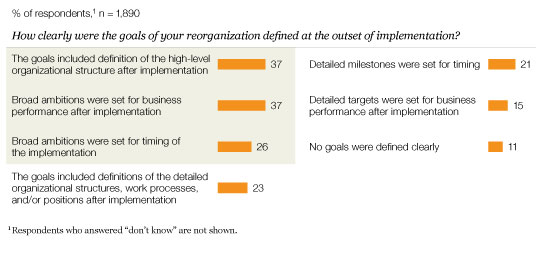
Getting results
A third of all respondents say they expected their redesigns to take six months or less to implement, another third say six months to a year, and the final third say more than a year. Thirty-seven percent of companies met their time lines; 43 percent underestimated and 22 percent overestimated,3 and the best success rates were reported by respondents whose companies set time frames either under 3 months or over 18 months (Exhibit 2).
Considering both the objectives and the timing of the redesigns, relatively few respondents—only 16 percent—say their companies met all objectives in the planned time frame (Exhibit 3). This level of success is likeliest at organizations responding to a crisis, where time is usually crucial, but even in that case, only 21 percent report fully meeting objectives on time. This result is tied with the share of respondents at organizations seeking to increase revenue.
Missing the time mark
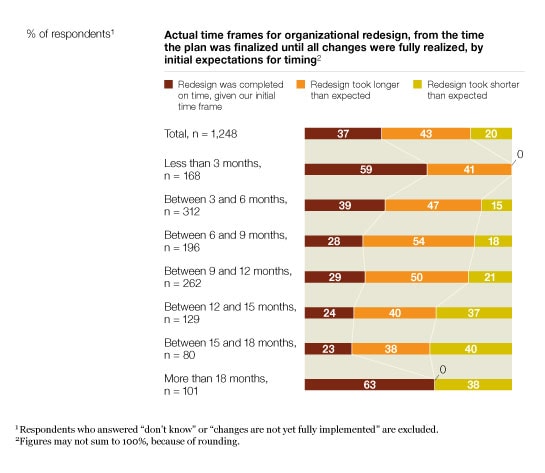
Partial success
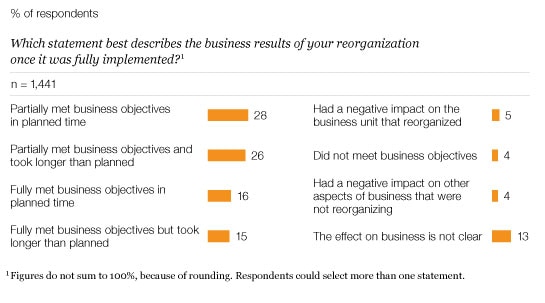
Notably, the highest share saying the redesign had a negative business impact on the area being reorganized—14 percent—are respondents who also say their redesigns were driven by a new leader’s desire to make changes, suggesting that redesigns do better when driven by a clear business rationale. Less surprisingly, those who were seeking to cut costs came in at a close second, at 12 percent, reinforcing how difficult it can be to balance immediate cost savings with long-term sustainability and competitiveness.
Looking at shareholder value for the whole company emphasizes that executives see redesign as a powerful tool: among respondents at companies that trade publicly and who could answer the question, 69 percent say their redesigns increased shareholder value (22 percent say the redesigns had no effect, and 9 percent say that it destroyed value). Executives with redesigns aimed at increasing revenue are likeliest to say they boosted value, and those who aimed at cost cutting and facilitating a merger are the likeliest to say value had been destroyed.
Morale is often a casualty when redesigns are implemented poorly, and the results of this survey reinforce that view. However, the results also show that the most widespread damage is relatively short-lived (Exhibit 4): 47 percent of respondents say morale was hurt in the short term, but that falls to 28 percent six months or more after the redesign was implemented.
Better morale over time
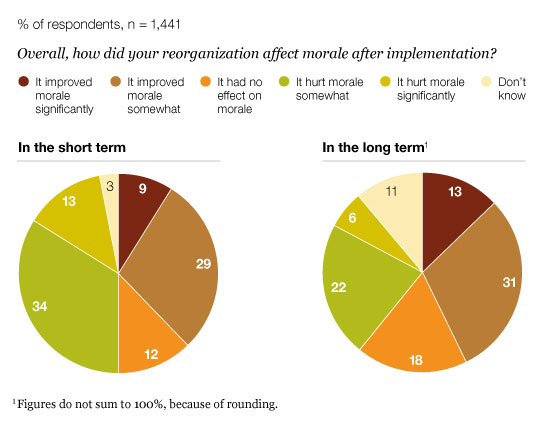
How the best organizations do it
Two of the top three challenges executives cite in implementing their redesigns successfully are employee distraction and demoralization (Exhibit 5).4 Furthermore, a third of respondents say that employee demoralization and resisting change had the most negative impact on their ability to reach their goals—more than those who say that a problem as basic as insufficient resources was an implementation challenge.
However, among respondents at the most successful organizations, the challenge most frequently cited as the most harmful is company leadership undermining the change. In our experience, this tends to happen when leaders wait too long to make difficult talent-management changes. In addition, a redesign that fundamentally changes the way the organization works frequently upsets those who rose to the top in the old system.
Given the potential for leadership resistance, it is thus particularly notable that far fewer respondents at successful organizations cite either employee distraction or demoralization as a challenge—and perhaps most interestingly, a full quarter say they faced none of the challenges we asked about.
Employee pushback
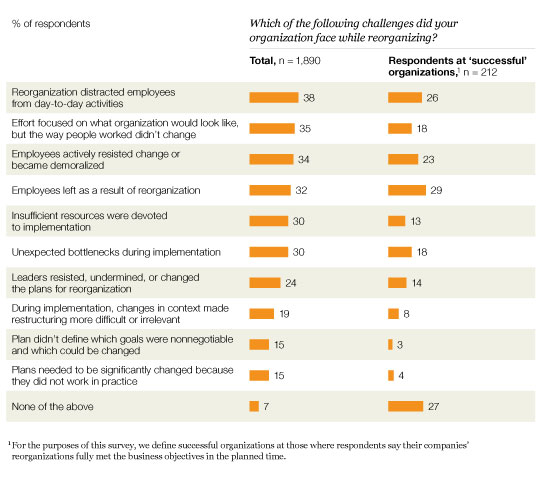
Quite possibly, there are two reasons why respondents at these organizations are much less likely to cite any challenges—and less likely to cite problems with distraction and demoralization. The first reason is that they say their implementation was faster: half say it took six months or less, compared with only 22 percent of others. The second is that executives at successful companies are much likelier than others to say they used certain tactics: their organizations’ strategies focused on changing mind-sets along with processes, roles, and behaviors, and their reorganization procedures included having a clear communications plan and ensuring that support systems supported the changes (Exhibit 6). Because of these tactics, employee pain was briefer and minimized by the system changes, and, in addition, employees clearly understood why they were being asked to change.
The right tools
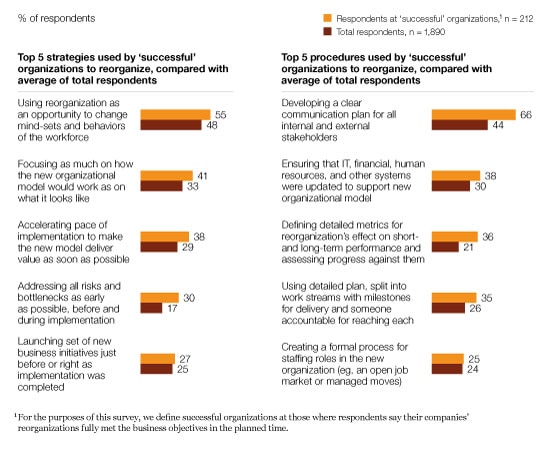
Looking ahead
The tactics used most by the most successful organizations suggest that all organizations implementing a redesign would benefit from explaining to employees how the new design works, ensuring that systems and processes support it, and winning hearts and minds.
The results also undercut the common perception that a staged, evolutionary process leads to more successful change. Indeed, a much better approach seems to consist of taking quick decisive action and then aligning people behind the change.
